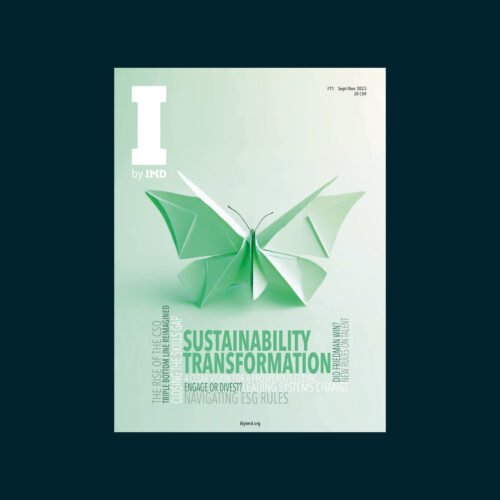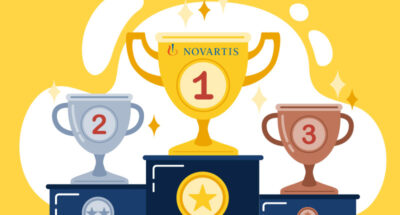
Thriving after 45: is the best still to come?
Neuroscience shows that business-critical cognitive skills can peak after middle-age, but only if we prioritize brain health. ...

by Misiek Piskorski, Tania Lennon Published September 29, 2023 in Human Resources • 9 min read •

More than 25 years ago, a pioneering McKinsey study underlined the “war for talent” as a strategic challenge for companies. The study strengthened the focus on talent management as a discipline with greater emphasis on talent identification and succession planning.
Yet even now, 80% of Chief Human Resources Officers (CHROs) say they lack the essential talent required to deliver their company’s strategy. Indeed, a quick survey of the literature conducted by the IMD Strategic Talent team in August suggests that no more than 15% of any organization is perceived as “talent” that should be invested in to support their progression toward bigger leadership roles. A great deal of effort in talent management is, therefore, expended in identifying these elusive high-potential employees to manage their trajectory toward target leadership positions.
However, there is limited published evidence for these numbers. With a global population of 7.8 billion and education rates higher than they have ever been, it seems counterintuitive to suggest that such a small percentage could be classified as “talent”.
Some researchers have been pushing back against what Yvonne Downs and Stephen Swailes at the University of Huddersfield have described as the “conceptualization of talent and talent management sustaining a narrative of scarcity and metaphor of war”. Aligned with changes in the world of work catalyzed by COVID-19 combined with a growing recognition that traditional approaches to talent management have not succeeded, there is a movement toward adopting more person-centric approaches to talent. This requires some fundamental alterations in the way we define and identify talent.
We reviewed the literature on talent management to pinpoint three core shifts in the “rules of talent” that need to be rewritten to address the talent gap. These new rules will enable organizations to better capitalize on the talent available to them to deliver sustained success.

No organization can escape the need to transform to become more sustainable. The need to act is urgent. It calls for strong leadership, difficult decisions, and deep cultural change. In Issue XI, we explore how to build sustainable organizations to succeed in turbulent times.
The importance of hiring for “fit” is based on the idea that similarity between the organization and the individual employee impacts performance. Person-organization fit has been linked to outcomes such as financial performance, job satisfaction, and turnover. Hiring for fit often focuses on the degree of congruence between the values of the individual and the organization.
There is clear evidence that a perception of common values leads to greater trust and, therefore, more autonomy for employees. This trust facilitates social integration and cohesion and further strengthens the company culture. In turn, a strong culture drives faster execution, as there are fewer process losses when assumptions, perspectives, and values are shared across team members and functions.
A strong culture has thus traditionally been perceived as a positive attribute for organizations, supporting continuity and consistency to preserve what is distinctive about the organization while also facilitating fast execution. The “attraction, selection, attrition” bias, where organizations and leaders tend to recruit people like themselves, results in increasing convergence in values and perspectives as tenure increases, creating a virtuous circle that constantly reinforces the existing culture.
While a close-knit culture breeds trust and facilitates rapid execution, it can also anchor organizations to the status quo so that they inherently resist change. In a world characterized by complexity and dynamism, organizations need to counter this rigidity by extending the range of perspectives and values they integrate. Organizations that select talent with more diversity in values, perspectives, and backgrounds benefit from greater cognitive resources and breadth of experience, which enables teams to engage in more complex problem-solving and innovation.
Being part of groups with diverse values and backgrounds is also good for employee well-being. In work environments where people feel able to be themselves and express different views, employees tend to experience less stress and are more engaged in their work. This further boosts performance.
How can organizations get the best of both worlds? Organizations need to decide what is absolutely central to their culture – what Ed Schein called “pivotal values” – and where they can flex. Greater diversity in what are known as the peripheral values of the organization supports adaptive change and innovation. This combination can be called “extension fit” because it maintains what is important while extending the breadth of perspectives and learning capacity of the organization.
To make extension fit work in practice requires leaders with high levels of social sensitivity. Encouraging people to express different views while creating space for individuals to explore and understand diverse perspectives enables organizations to translate diversity into creative solutions. Without leader support, “diverse” individuals recruited into the organization can experience rejection and are likely to leave, which further amplifies the effect of the “attraction-selection-attrition” bias.
One in 10 employees has a high level of talent, while two in 10 are basic talentGallup (2015). State of the American manager: Analytics and advice for leaders
Job descriptions continue to serve as vital tools to provide clarity about job expectations and outcomes. They enable role incumbents to understand how their position contributes to the strategy and define how success will be evaluated and measured. The practice of analyzing jobs to determine the knowledge, skills, and abilities (KSAs) required for a given role is grounded in scientific management: in the late 1800s, F W Taylor asserted that “workers were to be selected appropriately for each task” and “tasks and jobs should be rigorously defined based on an appropriate study of the work”.
In an era when human capital provided “resources” with an emphasis on stable, consistent, and practiced skills that could be measured and replicated through time-and-motion studies, this perspective on organizations as machines was essential to enable productivity and performance. However, work has changed significantly. The nature of jobs is constantly evolving, with automation and digitization prompting the disappearance of some roles and the emergence of others. For example, positions such chief digital officer have appeared in numbers only in the past seven years, with eight out of 10 CDOs the first in their organization to hold the role. It is estimated that 65% of organizational roles today will no longer exist in 15 years’ time.
Further, by removing the more repetitive and mundane components of jobs, technology has enriched many roles so that they encompass greater strategic breadth and complexity. This enrichment results in increased requirements for both cognitive and emotional intelligence.
Requirements for success within roles also change rapidly. For example, it is estimated that the life span of many skills in the digital space is about 18 months. This means that sustained success in roles is driven not by the possession of target skills and knowledge but by the ability to rapidly acquire new skills and knowledge and constantly adapt to new challenges.
Yet traditional succession plans continue to use existing role requirements to evaluate and develop talent pools. Too much rigor and focus on developing talent to fulfill current demands means that, by the time potential successors are nearing the target role, what is needed to succeed has dramatically shifted – or the role itself may have disappeared altogether.
In the context of shifting role demands, how do you develop robust talent pools to ensure you have the leadership talent you need in the medium to long term? Firstly, an inclusive approach that helps individuals own, harness, and amplify their talents to create value for the organization in new ways is not only a good talent strategy but also drives innovation and fuels dynamic capabilities that can support sustained competitive advantage.
Secondly, focusing development in the early- to mid-career stages on the development of the meta-competencies that comprise “situational judgment” – such as cognitive agility, emotional intelligence, and adaptive learning – can increase the capacity of future leaders to support the ongoing transformation of your business.

“The top 10 to 15% of an organization are its high potential talent.”- Michael Mankins (2017), Harvard Business Review
Meta-analyses have repeatedly shown that well-designed assessment processes can explain just under 40% of the variance in future job performance. This is typically achieved through a multi-method approach using a combination of tools targeted at the needs of the job. These include a measure of general mental ability, a structured interview focused on understanding current behaviors and skills and past experiences, a psychometric test focused on aspects of personality, and a work sample (role play, presentation, simulation, etc). Each component adds further explanatory power because it measures a different aspect of the person that informs the level of person-job fit – intelligence, personality, skills, and behaviors. By adding information from each source, assessments aim to judge how the individual is likely to perform. The better the fit between person and job, the better the performance, so ticking off different components of the job description provides a more rounded appraisal of the individual’s capabilities.
However, this approach may inherently limit the predictive power of assessments so that they have been unable to break beyond the 40% barrier over the past 100 years. Firstly, as discussed above, skills can rapidly become obsolescent. There is an inverse relationship between the dynamism of the environment and the value of experience: just like financial services, the past performance of your employee is no guarantee of future performance. An individual may have honed a particular set of skills but if job requirements change (as is likely) these may no longer support their performance.
Secondly, behaviors are context dependent. Behavioral choices are driven by a complex mix of situation, environment, individual, and situational judgment. So, the demonstration of target behaviors in one context does not mean that the individual will make the same choices in a new role or organization that contains different processes, challenges, culture – and leaders.
Using robust data from a range of valid assessment tools continues to be the gold standard and the pathway to optimizing prediction. In addition, technology-driven assessment tools such as game-based and AI-enabled adaptive assessment tools are providing a wealth of data that can provide new insights into the underlying drivers of performance. Advances in data science enable us to extract far more knowledge and understanding than previously possible.
By understanding the interdependencies and interactions between different facets of individuals and how these contribute to performance, we can create more integrated and dynamic models of leadership performance with greater predictive power. Further, these models yield increasingly sophisticated insights about how we can harness and develop the talents of our people and support their success in their roles.
The percentage of high potential employees to total employees is between 3% and 5%.- Eva Boštjančič and Zala Slana (2018), University of Ljubljana, Slovenia
Instead of a lean 15%, what if 50% of your organization was perceived as talent? Or 80%? What if you took the perspective that everyone in your organization was talent? The new talent mindset is inclusive, starting with the assumption that everyone has unique abilities. The key question is no longer, “Is this person ‘talent’?” but rather, “What is the nature of this person’s talent and how can we release, develop, amplify, and harness that talent to create value?”
New models and technologies in the talent space make this possible. With the new talent mindset, the goal is no longer to chart a series of sequential moves to achieve a coveted destination role. Instead, the primary focus of talent management is to leverage precision insights to support learning and accelerated adaptation in the context of rapidly changing roles and organizations. The new talent mindset focuses on engaging and enabling the talent available within your organization more effectively, cutting through old rules that can anchor progression planning to the past rather than accelerate your future.

Professor of Digital Strategy, Analytics and Innovation and Dean of Executive Education
Mikołaj Jan Piskorski, who often goes by the name Misiek, is a Professor of Digital Strategy, Analytics and Innovation and the Dean of Executive Education, responsible for Custom and Open programs at IMD. Professor Piskorski is an expert on digital strategy, platform strategy, and the process of digital business transformation. He is Co-Director of the AI Strategy and Implementation program.

Executive Director of the Strategic Talent Development initiative
Tania Lennon leads the Strategic Talent team for IMD. She is an expert on future-ready talent development, including innovative assessment methods to maximize the impact of talent development on individual and organizational performance. Lennon is a “pracademic”, blending a strong research orientation with evidence-based practice in talent development and assessment.

July 2, 2025 • by Michael Netzley in Talent management
Neuroscience shows that business-critical cognitive skills can peak after middle-age, but only if we prioritize brain health. ...

June 17, 2025 in Talent management
How do organizations recruit and retain staff amid a fierce global battle for the best people? Novartis’s Rob Kowalski explains how organizational culture can provide the winning edge in a competitive talent...

May 30, 2025 in Talent management
Natalia Wallenberg of Ahold Delhaize describes how one of the largest retailers in Europe is tackling the upskilling dilemma....

May 21, 2025 • by Richard Roi, Luca Condosta in Talent management
Non-linear career paths will give your future leaders the range to drive both performance and transformation, say Ric Roi and ABB’s Luca Condosta. Individuals must actively pursue diverse experiences, while organizations need...
Explore first person business intelligence from top minds curated for a global executive audience